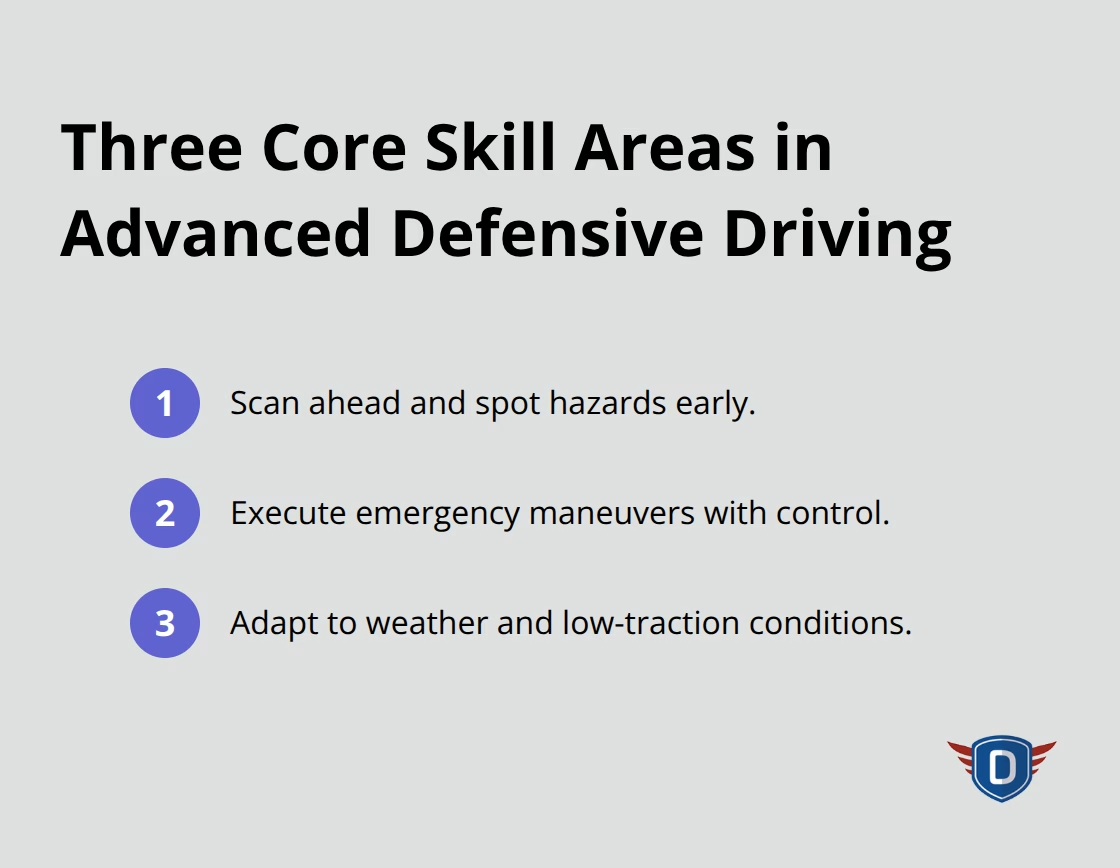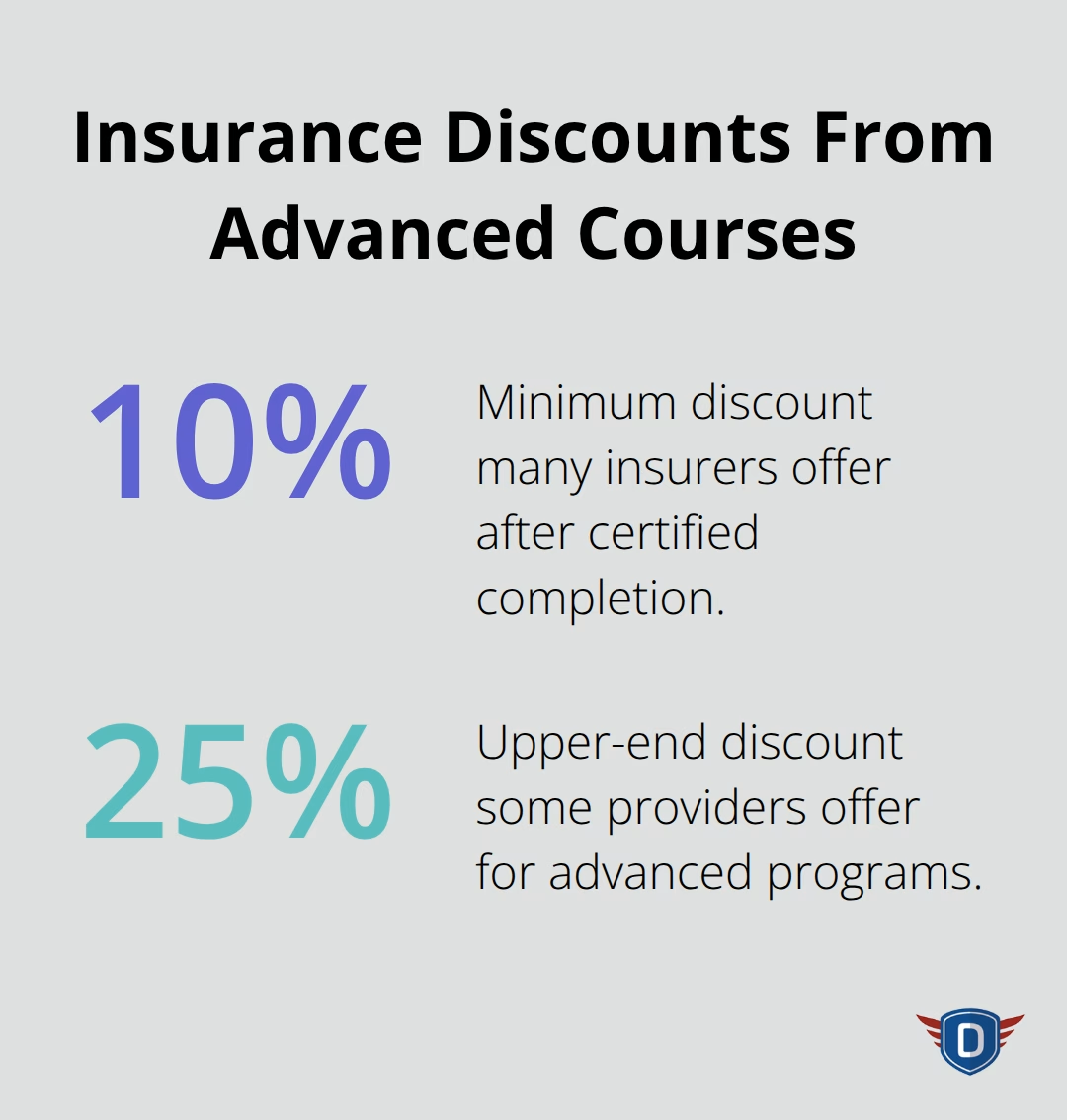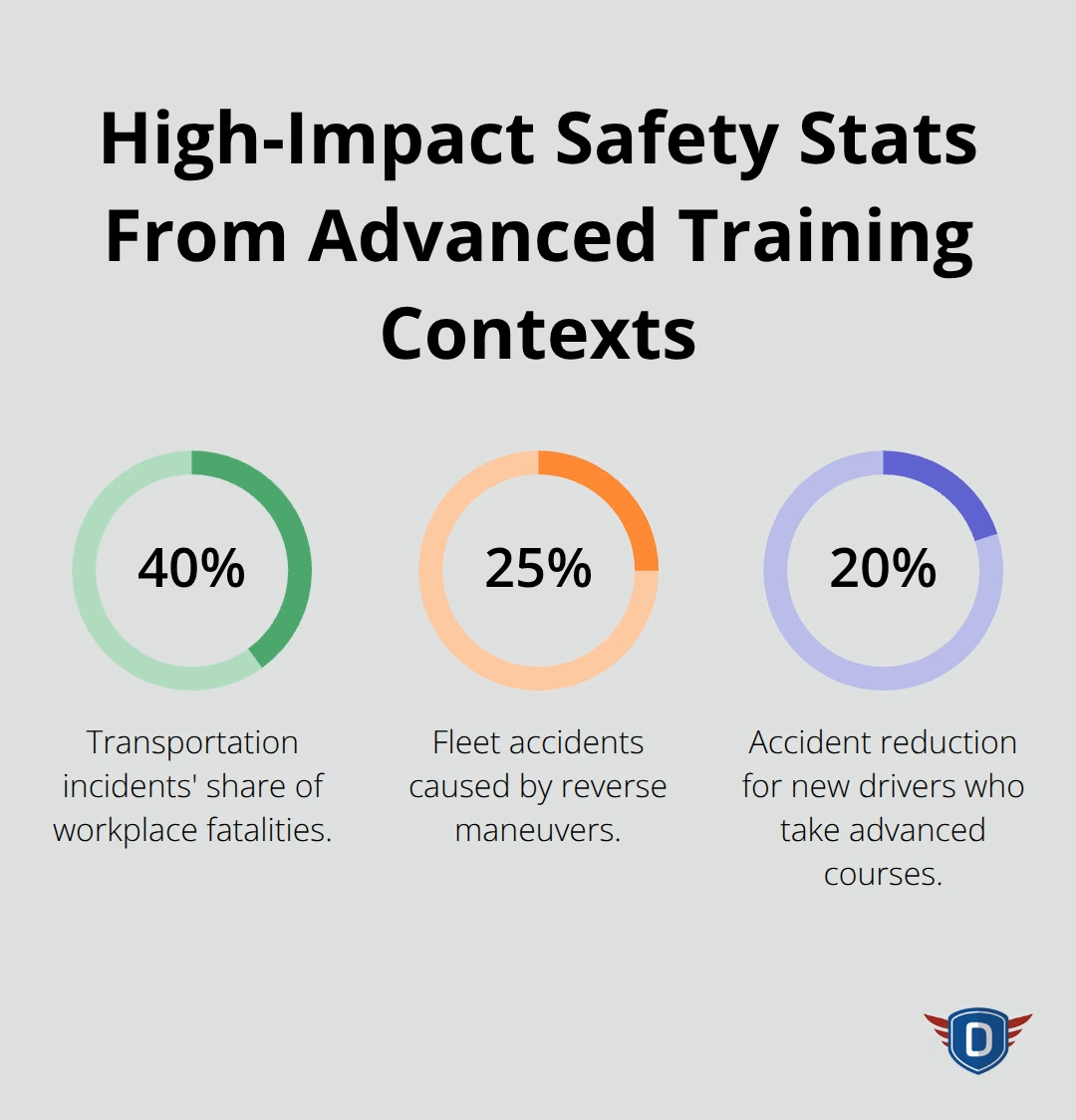Standard defensive driving teaches the basics, but real-world hazards demand more sophisticated skills. An advanced defensive driving course goes beyond traditional training to prepare drivers for complex scenarios.
At floridanewdriver.com, we see how these specialized programs transform good drivers into exceptional ones. The investment pays off through reduced accidents, lower insurance costs, and genuine confidence on the road.
What Skills Do Advanced Courses Actually Teach
Advanced defensive driving courses focus on three core areas that separate professional-level drivers from average ones. The National Safety Council reports that over 90% of automobile crashes stem from human performance errors, making advanced skill development the most effective accident prevention strategy.
Spotting Danger Before It Develops
Advanced hazard recognition training teaches drivers to scan 12 to 15 seconds ahead, a technique the U.S. Department of Transportation recommends for commercial drivers. Students practice identification of subtle warning signs like aggressive driver behavior patterns, pedestrian movement cues, and vehicle maintenance issues that signal potential problems. The training emphasizes traffic flow dynamics and recognition of high-risk scenarios like blind spot violations, which present significant safety challenges according to the National Highway Traffic Safety Administration.

Emergency Response Under Pressure
Emergency maneuver instruction covers threshold braking, skid control, and evasive steering techniques using specialized equipment like skid cars. Students learn controlled high-speed lane changes and proper corner methods to prevent understeer or oversteer. The Mid-Ohio School charges around $375 for one-day defensive courses that include wet brake practice and emergency stop drills. These skills prove vital since back accidents alone account for 25% of all vehicle incidents.
Mastery of Adverse Conditions
Weather adaptation training addresses specific challenges like black ice navigation, reduced visibility protocols, and traction management on wet surfaces. Advanced courses simulate dangerous conditions in controlled environments and teach drivers to adjust follow distances beyond the standard three-second rule based on road conditions. Work zone navigation receives special attention since these areas require speed reductions of at least 10 mph and heightened awareness of construction worker safety.
These advanced techniques prepare drivers for the real benefits that extend far beyond basic road safety (including significant financial advantages and legal protections).
What Financial and Safety Returns Can You Expect
Advanced defensive driving courses deliver measurable returns that extend far beyond basic road safety. The University of California, Davis research shows organizations that implement comprehensive defensive driving programs achieve a 2-to-1 return on investment, with combined online training and practical supervision that boosts ROI to 5-to-1. Insurance companies recognize this value through premium discounts that range from 10% to 25% for drivers who complete certified advanced programs, while the National Safety Council reports that single accident costs can exceed $1.4 million, which makes prevention training a smart financial strategy.

Insurance Savings and Legal Protection
Most major insurance providers offer substantial discounts for advanced defensive driving completion, with State Farm and Allstate that lead discount programs and can reduce annual premiums by hundreds of dollars. Traffic courts across 48 states accept National Safety Council certifications for ticket dismissal or point reduction, which provides immediate legal benefits for drivers who face violations. Advanced training also strengthens legal position in accident scenarios, as documented skills training demonstrates due diligence and responsible driving practices that insurance adjusters and attorneys value during claim reviews.
Real-World Emergency Preparedness
Advanced courses prepare drivers for lane-change crashes that occur frequently through specific mirror adjustment techniques and scan patterns. Students master threshold brakes and skid recovery with professional equipment, skills that prove vital during the peak drowsy driving hours between midnight and 6 AM when reaction times decline significantly. The controlled environment practice with skid cars and emergency maneuvers builds muscle memory that activates automatically during real emergencies (which reduces panic responses that cause secondary accidents).
Professional Confidence Development
Advanced training eliminates the guesswork from hazardous situations through systematic decision-making frameworks that professional drivers rely on daily. Students learn to maintain proper following distances and adjust space based on weather conditions, techniques that reduce stress during challenging driving conditions. The combination of technical skills and situational awareness creates genuine confidence that transforms nervous drivers into calm, competent operators who handle unexpected situations with professional composure.
These financial benefits and safety improvements make advanced courses attractive to specific groups of drivers who face unique challenges on the road (from commercial operators to new drivers seeking additional protection).
Which Drivers Benefit Most From Advanced Training
Transportation incidents account for 40% of workplace fatalities according to the National Safety Council, which makes advanced defensive training essential for commercial drivers and fleet operators who face daily road exposure. Professional drivers accumulate 50,000 to 100,000 miles annually compared to the average driver’s 12,000 miles, and this multiplies their accident risk and insurance liability. Fleet managers report accident reduction rates of 15% to 30% after they implement advanced programs, with Fortune 100 companies that routinely invest in National Safety Council certification for their drivers.
Commercial Drivers Need Professional-Grade Skills
Professional truck and van drivers benefit most from advanced courses because their vehicles require extended stops and specialized maneuvers. The U.S. Department of Transportation mandates four-second follow distances for commercial vehicles that travel up to 40 mph, with additional seconds required for higher speeds that most standard courses never address. Commercial drivers also face unique challenges like work zone navigation and reverse maneuvers that cause 25% of fleet accidents (which makes specialized training a business necessity rather than an option).

New Drivers Gain Competitive Advantages
Recent license holders who complete advanced courses within their first year show 20% fewer accidents than those who rely solely on basic driver education. The Alive at 25 program from the National Safety Council specifically targets drivers aged 15-24 because this group represents the highest accident risk category. New drivers who invest in threshold brake and skid control courses develop muscle memory for emergency situations before they develop bad habits that experienced drivers must unlearn.
Violation History Drivers Face Insurance Consequences
Drivers with traffic violations face insurance premium increases of 20% to 40% that can persist for three to five years, and this makes advanced course completion a financial necessity. Traffic courts in 48 states accept advanced defensive certificates for point reduction and ticket dismissal (which provides immediate legal and financial relief). Drivers with DUI convictions often face mandatory advanced requirements, and voluntary completion demonstrates responsibility to insurance companies and legal authorities who evaluate risk profiles.
Final Thoughts
Advanced defensive driving course completion transforms ordinary drivers into skilled professionals who handle emergencies with confidence. The financial benefits alone justify the investment, with insurance discounts of 10% to 25% and potential accident cost savings that exceed $1.4 million per incident. Professional drivers see accident reduction rates of 15% to 30%, while new drivers gain competitive advantages that last throughout their careers.
The skills learned through threshold brakes, skid control, and hazard recognition become automatic responses during real emergencies. These techniques prove especially valuable during peak risk periods like midnight to 6 AM and adverse weather conditions that challenge even experienced drivers. Advanced courses prepare drivers for situations that basic training never addresses (including work zone navigation and emergency lane changes).
We at floridanewdriver.com provide comprehensive driver education programs with certified instructors who offer personalized guidance in supportive environments. Our focus extends beyond basic requirements to help students develop lifelong safe driving habits that protect them and others on the road. The combination of immediate insurance savings, legal protection, and enhanced safety skills makes advanced training a smart investment for any serious driver who values long-term protection and professional competence behind the wheel.





![The Best Online Traffic Schools in Florida [2025]](https://floridanewdriver.com/wp-content/uploads/emplibot/online-traffic-school-florida-hero-1765422499.avif)

